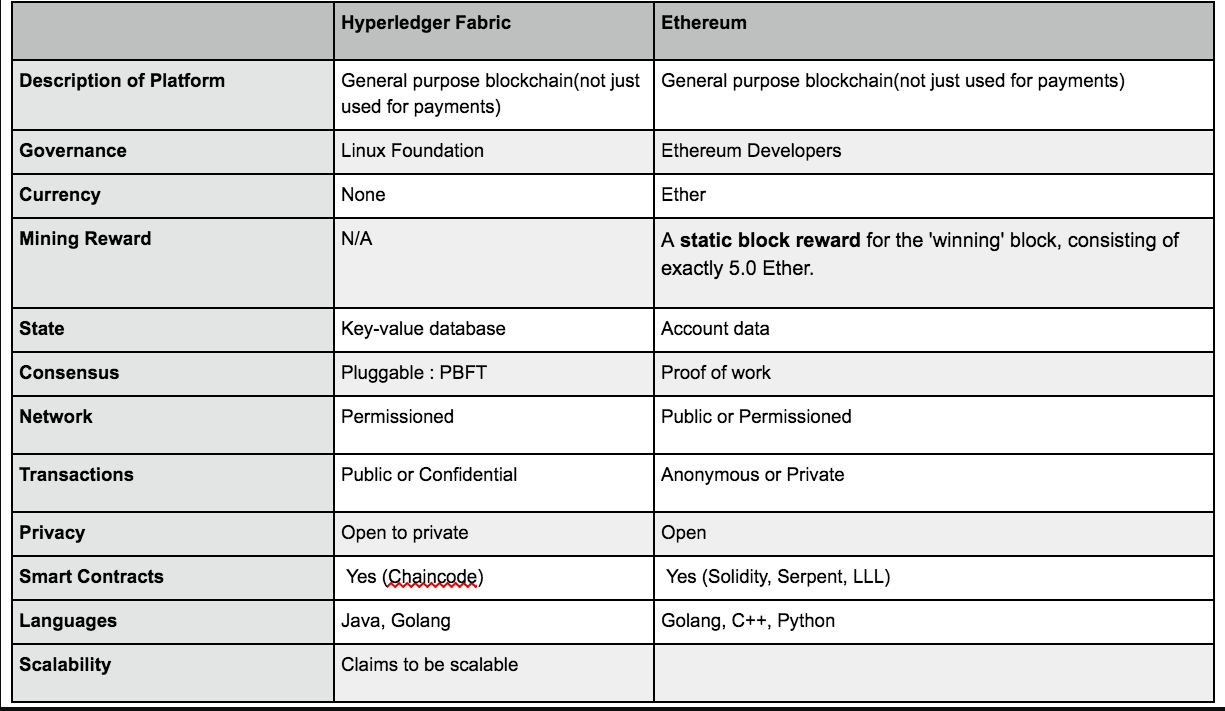BlockChain FAQs
- Introduction:
Distributed Ledger Technology (DLT) has stirred a lot of interest and enthusiasm across multiple industries. A distributed ledger is a type of database spread across multiple sites, regions, or participants. Every record stored in the distributed ledger is timestamped and has its very own cryptographic signature which is used to both validate and secure the network.
Enterprises are looking into distributed ledger technology to process, validate or authenticate transactions or other types of data exchanges in a more secure and scalable way. There are a wide-range of open-source projects that are available to developers looking to build applications using this technology.
Two of the leading platforms in this space are Ethereum and Hyperledger.
- What is HYPERLEDGER?
Hyperledger doesn’t refer to a specific technology, but rather it is a Linux Foundation banner project for multiple blockchain and Ditributed Ledger T technologies which support the collaborative development of blockchain-based distributed ledgers each of which have slightly different characteristics.

- What are the different types of Hyperledger Frameworks?
Hyperledger Sawtooth is a modular platform for building, deploying, and running distributed ledgers. Hyperledger Sawtooth includes a novel consensus algorithm, Proof of Elapsed Time (PoET), which targets large distributed validator populations with minimal resource consumption. Type: DLT, Smart Contract Engine
Hyperledger Fabric is intended as a foundation for developing applications or solutions with a modular architecture, Hyperledger Fabric allows components, such as consensus and membership services, to be plug-and-play. Fabric is a blockchain framework implementation and one of the Hyperledger projects hosted by The Linux Foundation. Intended as a foundation for developing applications or solutions with a modular architecture, Hyperledger Fabric allows components, such as consensus and membership services, to be plug-and-play. Hyperledger Fabric leverages container technology to host smart contracts called “chaincode” that comprise the application logic of the system. Hyperledger Fabric was initially contributed by Digital Asset and IBM, as a result of the first hackathon. Type: DLT, Smart Contract Engine
Hyperledger Burrow is a permissionable smart contract machine. The first of its kind when released in December, 2014, Burrow provides a modular blockchain client with a permissioned smart contract interpreter built in part to the specification of the Ethereum Virtual Machine (EVM). Type: Permissioned smart contract application engine
Hyperledger Iroha is a blockchain platform implementation and one of the Hyperledger projects hosted by The Linux Foundation. Hyperledger Iroha is designed to be simple and easy to incorporate into infrastructural projects requiring distributed ledger technology. Hyperledger Iroha features a simple construction; modern, domain-driven C++ design, emphasis on mobile application development and a new, chain-based Byzantine Fault Tolerant consensus algorithm, called Sumeragi. Hyperledger Iroha was initially contributed by Soramitsu, Hitachi, NTT Data and Colu. Type: DLT, Smart Contract Engine, Utility Libraries
Hyperledger Indy is a distributed ledger, purpose-built for decentralized identity. It provides tools, libraries, and reusable components for creating and using independent digital identities rooted on blockchains or other distributed ledgers so that they are interoperable across administrative domains, applications, and any other “silo.”Because distributed ledgers cannot be altered after the fact, it is essential that use cases for ledger-based identity carefully consider foundational components, including performance, scale, trust model, and privacy. In particular, Privacy by Design and privacy-preserving technologies are critically important for a public identity ledger where correlation can take place on a global scale.For all these reasons, Hyperledger Indy has developed specifications, terminology, and design patterns for decentralized identity along with an implementation of these concepts that can be leveraged and consumed both inside and outside the Hyperledger Consortium. Type: Distributed ledger and utility library
- What are the Hyperledger Tools?
Hyperledger Cello aims to bring the on-demand “as-a-service” deployment model to the blockchain ecosystem to reduce the effort required for creating, managing and terminating blockchains. Type: Utility
- What Is Ethereum?
Ethereum is an open source platform that enables developers to build and deploy decentralised applications. It is a public blockchain network with it’s own built-in cryptocurrency called Ether.
- What is the difference between ETHEREUM VS. HYPERLEDGER FABRIC?
The most fundamental difference between Ethereum and Hyperledger is the way they are designed and their target audience.
- Ethereum with it’s Ethereum Virtual Machine (EVM), smart contract and public blockchain is mostly targeted towards applications that are distributed in nature.
- On the other hand, Fabric has a very modular architecture and provides a lot of flexibility in terms of what you want to use and what you don’t. It’s pretty much a la carte and is targeted at businesses wanting to streamline their process by leveraging blockchain technology. For example, it is not possible in Ethereum to have a transaction visible to someone, but not visible to others (a requirement that is very common in business). Fabric allows this and much more.
Ethereum’s permissionless mode of operation and its total transparency comes at the cost of performance scalability and privacy. Fabric solves performance scalability and privacy issues by permissioned mode of operation and specifically by using a BFT algorithm and fine-grained access control. Further, the modular architecture allows Fabric to be customized to a multitude of applications. An analogy to a versatile toolbox can be drawn.
Ethereum also has a built in cryptocurrency (ETH) and thus can be a very good match for applications that need this inbuilt. However, this could also be a disadvantage as there are several use cases where the cryptocurrency is not really needed.


